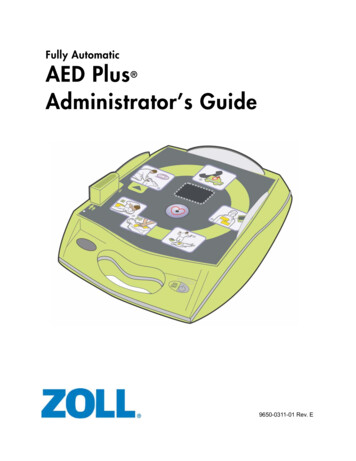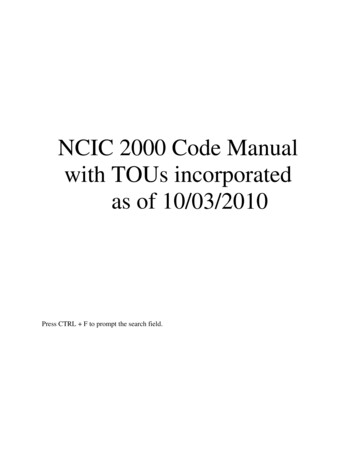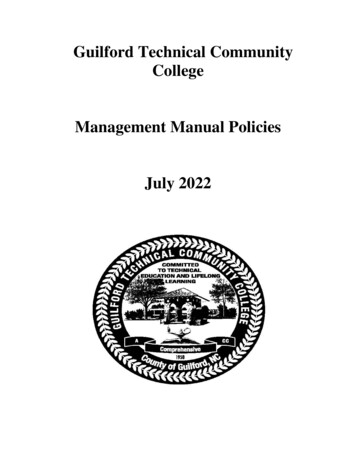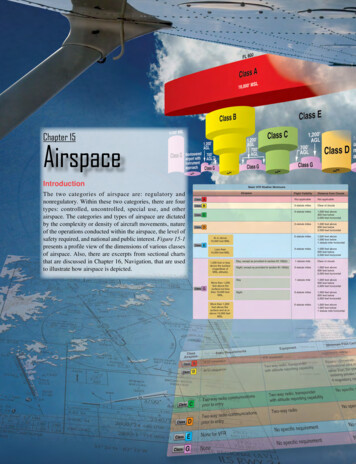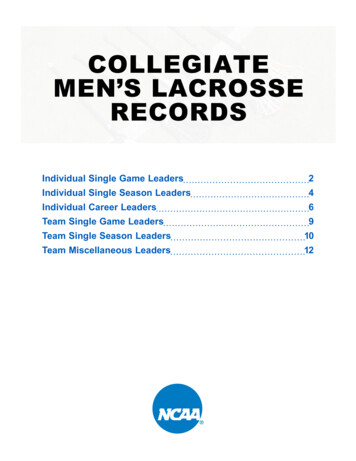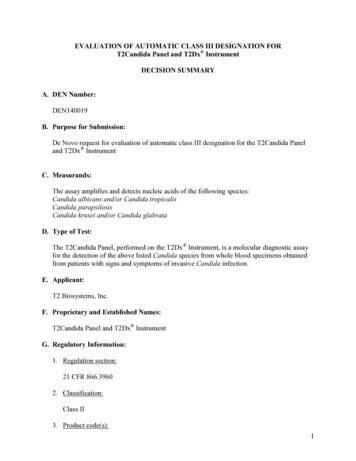
Transcription
EVALUATION OF AUTOMATIC CLASS III DESIGNATION FORT2Candida Panel and T2Dx InstrumentDECISION SUMMARYA. DEN Number:DEN140019B. Purpose for Submission:De Novo request for evaluation of automatic class III designation for the T2Candida Paneland T2Dx InstrumentC. Measurands:The assay amplifies and detects nucleic acids of the following species:Candida albicans and/or Candida tropicalisCandida parapsilosisCandida krusei and/or Candida glabrataD. Type of Test:The T2Candida Panel, performed on the T2Dx Instrument, is a molecular diagnostic assayfor the detection of the above listed Candida species from whole blood specimens obtainedfrom patients with signs and symptoms of invasive Candida infection.E. Applicant:T2 Biosystems, Inc.F. Proprietary and Established Names:T2Candida Panel and T2Dx InstrumentG. Regulatory Information:1. Regulation section:21 CFR 866.39602. Classification:Class II3. Product code(s):1
PIINSU4. Panel:83- MicrobiologyH. Intended Use:1. Intended use(s):The T2Candida Panel and T2Dx Instrument is a qualitative T2 Magnetic Resonance(T2MR ) assay for the direct detection of Candida species in EDTA human whole bloodspecimens from patients with symptoms of, or medical conditions predisposing thepatient to, invasive fungal infections. The T2Candida Panel identifies five species ofCandida and categorizes them into the following three species groups:1. Candida albicans and/or Candida tropicalis,2. Candida parapsilosis3. Candida glabrata and/or Candida kruseiThe T2Candida Panel does not distinguish between C. albicans and C. tropicalis. TheT2Candida Panel does not distinguish between C. glabrata and C. krusei.The T2Candida Panel is indicated for the presumptive diagnosis of candidemia. TheT2Candida Panel is performed independent of blood culture. Concomitant blood culturesare necessary to recover organisms for susceptibility testing or further identification.The T2Candida positive and negative External Controls are intended to be used as qualitycontrol samples with the T2Candida Panel when run on the T2Dx instrument system.These controls are not intended for use with other assays or systems.2. Indication(s) for use:Same as Intended Use3. Special conditions for use statement(s):For prescription use only.4. Special instrument requirements:The T2Candida Panel is performed on the T2Dx Instrument.2
I. Device Description:The T2Candida panel and T2Dx Instrument is comprised of the T2Candida Panelperformed on the T2Dx Instrument. The T2Candida Panel is a qualitative moleculardiagnostic assay that employs a whole blood compatible PCR amplification followed by T2magnetic resonance (T2MR) detection. The T2Candida Panel is performed on the T2Dx Instrument which executes all steps after specimen loading. A K 2 EDTA whole bloodspecimen is loaded onto the T2Candida Sample Inlet, which is then placed on theT2Candida Base along with the T2Candida Reagent Pack. The Reagent Pack contains theinternal control, amplification reagent, enzyme and the probe-coupled superparamagneticparticles for each Candida target. Three milliliters of the blood specimen is transferred tothe T2Dx Instrument where lysis of the red blood cells, concentration and lysis of theCandida cells and amplification of the Candida DNA takes place. Amplification productsare detected by T2MR detection using species-specific probes which are attached to thesuperparamagnetic particles. At the end of each assay, the T2Dx Instrument uses a bleachsolution to neutralize all liquids on the cartridge to mitigate the risk of ampliconcontamination. The assay provides an identification of Candida albicans and/or Candidatropicalis, Candida parapsilosis, and Candida glabrata and/or Candida krusei. The testdoes not distinguish between C. albicans and C. tropicalis. The test does not distinguishbetween C. glabrata and C. krusei.J. Standard/Guidance Document Referenced (if applicable):IEC 61010-1:2001, (Second Edition). Safety requirements for electrical equipment formeasurement control and laboratory use – General requirements. 2001IEC61010-2-010:2003 (Second Edition). Safety requirements for electrical equipment formeasurement, control, and laboratory use – Part 2-010. Particular requirements forlaboratory equipment for the heating of materials. 2003IEC 61010-2-081:2001 (First Edition) A1:2003. Safety requirements for electricalequipment for measurement, control and laboratory use – Part 2-081: Particularrequirements for automatic and semiautomatic laboratory equipment for analysis andother purposes. 2001IEC 61010-2-101:2002 (Second Edition). Safety requirements for electrical equipmentfor measurement, control, and laboratory use. Particular requirements for in vitrodiagnostic (IVD) medical equipment. 2002.IEC 61326-1:2005. Electrical equipment for measurement, control and laboratory use –EMC requirements – Part 1: General requirements. 2005IEC 61326-2-6:2005. Electrical equipment for measurement, control and laboratory use –EMC requirements – Part 2-6: Particular requirements – In vitro diagnostic (IVD)medical equipment. 2005CISPR 11:2003 Group 1 Class A. Industrial, scientific and medical equipment –Radiofrequency disturbance characteristics – Limits and methods of measurement. 2003CLSI MM03-A2. Molecular Diagnostic Methods for Infectious Diseases; ApprovedGuideline. 2008CLSI EP17-A2. Protocols for Determination of Limits of Detection and Limits ofQuantitation; Approved Guideline. 2013.3
CLSI EP07-A2. Interference Testing in Clinical Chemistry. 2007CLSI EP05-A2. Evaluation of Precision Performance of Quantitative MeasurementMethods. 2005CLSI EP25-A. Evaluation of Stability of In Vitro Diagnostic Reagents. 2013.LIS01-A2. Standard Specification for Low Level Protocol to Transfer Messages BetweenClinical Laboratory Instruments and Computer Systems; Approved Standard – SecondEdition. Maintained by CLSI. 2009LIS02-A2. Standard Specification for Transferring Information Between ClinicalLaboratory Instruments and Information Systems; Approved Standard – Second Edition.Maintained by CLSI. 2008ISTA 7E. Testing Standard for Thermal Transport Packaging Used in Parcel DeliverySystem Shipment. 2010ISTA 2A. Partial Simulation Performance Test (ASTM D5276 – Drop Test). 2011.CLSI EP12-A2. User Protocol for Evaluation of Qualitative Test Performance; ApprovedGuideline – Second Edition. 2014.K. Test Principle:In the T2Candida Panel and the T2Dx Instrument a single pair of pan-Candida primershybridizes to conserved sequences within the 5.8S and 26S ribosomal RNA operon ofCandida species and amplify the intervening transcribed spacer 2 sequence (ITS2) releasedfrom the lysed Candida cells contained in the specimen. The primers are mixed in a ratiosuch that an asymmetric product produces a predominantly single stranded nucleic acid afteramplification. The primers are designed to also amplify the internal control. Speciesspecific and internal control-specific probes provide the specificity of the assay. Theinstrument detects the amplified PCR product directly in the whole blood matrix byamplicon-induced agglomeration of superparamagnetic particles to which the speciesspecific and internal control-specific probes are attached. The detection method measuresthe spin-spin relaxation signals of water molecules. For these measurements, the T2Dx Instrument utilizes a small permanent magnet and a specialized radio frequency coil tomeasure the T2MR signal from the water molecules. T2MR measures the disorder of thenuclear spins of the water molecules contained in the sample and this disorder is directlyproportional to the superparamagnetic particle clustering state. The T2Dx Instrumentreports a positive or negative result for each detection channel [C. albicans/C. tropicalis(A/T), C. parapsilosis (P), C. krusei/ C. glabrata (K/G) and internal control (IC)].L. Performance Characteristics:1. Analytical performance:a. Precision/ReproducibilityA multicenter reproducibility study was performed to determine the run to run,reagent lot, day to day, and site to site reproducibility. Testing was performed atthree sites (two external and one internal) with a panel of three Candida species (C.albicans, C. parapsilosis and C. glabrata), each tested at two concentrations (1 – 2X4
3-4 X LoDNegativeN/AabSite 1Site 2Site 3All sitesSite 1Site 2Site 3All 100%Two false positive results in the P channelOne false positive result in the P channelb. Linearity/assay Reportable Range:Not Applicablec. Traceability, Stability, Expected Values (controls, calibrators, or methods):The T2Candida Panel and T2Dx Instrument require two types of controls, theinternal control and the external controls. The Internal Control (IC) is introduced intoeach specimen during sample processing on the T2Dx instrument; the pan-Candidaprimers are designed to amplify the target Candida species and the internal controlDNA. The IC is designed to report on the presence of any inhibitors in the clinicalspecimen and on any instrument-related errors. The signal cut-off for the IC is a(b)(4)If the IC signal is below its cutoff and if the patient specimen is(b)(4)negative for all Candida targets, the specimen result cannot be determined and the ICresult will be flagged as “Invalid” by the software resulting in an invalid test. If anyof the Candida targets is determined to be positive, the specimen will be reported aspositive for that target, regardless of the performance of the IC.The external controls are provided in a kit and include both positive and negativecontrols prepared in a whole blood matrix. The T2 positive external control includestwo blends of Candida species which can interrogate each T2Candida detectionchannel. The T2Candida A/P/G positive external control is comprised of a blend ofC. albicans, C. parapsilosis and C. glabrata. The T/P/K positive external control iscomprised of a blend of C. tropicalis, C. parapsilosis and C. krusei. The Candidaconcentration in the positive external controls is at least 3-5X LoD. The T2 negativeexternal control is a whole blood specimen free of any Candida cells.As noted in sections 3a and 3b below, clinical studies were conducted usingprospectively collected specimens and contrived specimens. During the clinical andanalytical studies for the T2Candida assay, fresh whole blood external controls wereused; a positive and negative control was run each day of the contrived andprospective arms of the study; positive controls alternated between the APG and theTPK controls. A summary of the quality control test results across all sites is listed inTable 2 below.6
Table 8. Species Providing an Invalid IC or Positive Candida Results When Testedat 106 CFU/mL but Not When Tested at Clinically Relevant Concentrations; NotConsidered to be Cross ReactiveOrganisms Giving Invalid IC Results at 106 CFU/mLCandida albidusAspergillus flavusCandida dubliniensisAspergillus fumigatusCandida gigantensisAspergillus nigerCandida guilliermondiiAspergillus terreusCandida kefyrExophiala xenobioticaCandida lunataFusarium proliferatumCandida lusitaniaeFusarium oxysporumCandida nivariensisFusarium solaniCandida norvegensisKluyveromyces delphensisCandida pelliculosaPichia anomalaCandida utilisPaecilomyces variotiiCandida viswanathiiScopulariopsis brevicaulisCryptococcus neoformans Trichosporon asahiiRhodotorula glutinisTrichosporon inkinTrichosporon mucoidesTrichoderma reeseiOrganisms Giving Positive Candida Results at 106 CFU/mLCandida rugosaAcinetobacter lwoffiiCandida sojaeEscherichia coliE. faecalisThe following species were shown to cross react when tested at any concentration: C.bracarensis, S. cerevisiae, C. metapsilosis and C. orthopsilosis (Table 9 below).In order to determine the effect of the presence of bacteria in the specimen on the ICvalue in actual clinical specimens, a review of the T2 signal data for 63 prospectivelyanalyzed specimens that were positive for bacteria (as determined by thecorresponding blood culture) was performed. The T2 signals for the internal controlfor all specimens was greater than the cutoff value, indicating that for samplescontaining clinically relevant organism concentrations, the internal control would bewithin acceptable levels and would not result in an invalid test result.13
g.Interfering SubstancesAn interfering substances study was performed to determine and characterize theeffects of potential endogenous and exogenous interfering substances on theperformance of the T2Candida Panel and the T2Dx Instrument. Interference testingwas performed using a paired-difference format; the potentially interfering substancewas added to a Candida-spiked sample at high concentration (to simulate worse case)and the bias relative to a Candida spiked control containing no interfering substanceswas determined. Substances were considered to be interfering if the T2 signal (inmsec) was decreased by 30% or greater as compared to the sample containing nointerferent. After testing average T2MR signal, standard deviation, %CV and %positive were evaluated for each sample.A total of seven substances representing possible patient underlying conditions weretested at concentrations from 1X to 38X above clinical levels, with most at 3Xclinical levels (Table 10).Table 10. Endogenous Substances Evaluated to Represent Human Underlying ConditionsUnderlying Sourceor erferentHuman DNA(Buffy LTRenal FailureMultiple5E7 cells/mL5-21 µmol/L150 mg/LHemoglobinIntralipid1-2 g/L0.34-3.7 mmol/L or0.065 mg/dL(triglycerides)39-51 g/L6-13 g/L6-17 mg/L1.1-14.3 mmol/LCirculating humanDNA50 mg/L17-50 U/L (plasma)9-48 U/LProtein (albumin)Immunoglobulin GCreatinineUreaTest ConcentrationWBC 3.5-11E7cells/mL0-3.4 µmol/LASTLipemiaHyperproteinemiaReference LevelN/Anormal limit of 50 U/Luppernormal limit of 48 U/L22.4 g/L1.3 mg/dL40 g/L15 g/L50 mg/L42.9 mmol/L (2.58mg/mL)1 µg/mL15
Twenty four exogenous substances were tested at concentrations from 1X to 38Xabove clinical levels (Table 11). Potential exogenous interferents were tested in setsof three for a total of eight interferent pools. All interferents were added to healthydonor blood; Candida species were spiked into the samples at 3X LoD using inoculacontaining either the multi-spike combinations of C. albicans/C. parapsilosis/C.glabrata or C. tropicalis/C. parapsilosis/C. krusei and tested in triplicate. If assayinterference, as measured by a decrease in T2 signal by 30% or greater, was detectedwith any of the interferent pools, each interferent present in the pool was prepared asan individual test to determine which substance was acting as an interferent with theassay’s performance.Results indicated interference with the signal for Candida species or with the signalfor the internal control for the following substances: Feraheme, Magnevist, EDTA,Ablavar, and samples with an interferent simulating lipemia (Intralipid).Invalid Results: 12/1647 (0.7%)False Positives : 5/1647 (0.3%)Table 11. Exogenous Substances EvaluatedExogenous InterferentEDTAHeparinCalcium HypochloriteFluconazoleMicafunginFerumoxytol (Feraheme)MRI Contrast Agent:Magnevist (gadopentetatedimeglumine, Gd-DTPA)MRI Contrast Agent: Ablavar(gadofosveset or Vasovist)Amphotericin B TrihydrateAmphotericin B, acinTazobactam (Tazobac)Gentamycin sulfateLinezolidAzithromycin (Zithromax)Clindamycin (Cleocin)MetronidazoleReference Level2 mg/mL350-1000 U/LNA65.2-81.5 µmol/L100 mg dosage/day510 mg/dosage, 30 mg/mL0.01 mmol/kgTest Concentration6 mg/mL3000 U/L8% (80 mg/mL)245 µmol/L (75 µg/mL)60 mg/L306 mg/L5.4 mmol/L (6.86 mg/mL)0.03 mmol/kg1.6 mmol/L (1.56 mg/mL)1 mg/kg/day3-5 mg/kg/day54.5 mg/L270 mg/L6g3.6 g/L12.4-27.6 µmol/L1g69.0 µmol/L (100 µg/mL)600 mg/L1.51-15.1 µmol/L4.5 g10.5-20.9 µmol/L600 mg0.4-5.1 µmol/L4.0-29.7 µmol/L35-234 µmol/L30.2 µmol/L (10µg/mL)8.1 g/L21 µmol/L (10 µg.mL)360 mg/L15.3 µmol/L (11.5 µg/mL089.1 µmol/L (41.4 µg/mL)701 µmol/L (119.9 µg/mL)16
performed using samples spiked with 1000 CFU/mL (2000 CFU/assay).A possible total of 175 negative samples were run. Three of these samples were falsepositive (all with samples spiked at 100 CFU/mL) for a false positive rate of 1.7%.j.Specimen Stability at 2-8 CIn order to support a labeling recommendation for storage of blood samples at 2 - 8 Cprior to testing, a specimen stability study was performed. Ten replicates of wholeblood specimens were spiked with each of the target Candida species at aconcentration of 100 CFU/mL. The organism concentration was determined bycolony count at Day 0, Day 1 and Day 3 of storage. Results indicated that theorganism concentration in samples held for 1 day at 2 – 8 C showed a change inorganism concentration of -9% to 12.4%. Colony count results obtained after threedays of storage showed a decrease in organism concentration of -4% to -17%. Devicelabeling indicates that blood specimens should be tested as soon as possible aftercollection and that specimens held for longer than one day at 2 - 8 C may result in adecrease of viable organisms in the specimen.k.Lysis Tube and Reagent StabilityA stability study was performed to determine the shelf-life of the reagents and thelysis tubes at the recommended temperatures. Reagents were removed from the kitsand each component was evaluated using quality control methods applied to the bulkreagents prior to kit fill. Results were compared to results obtained with recentlymanufactured reagents; all acceptance criteria were met indicating all reagentsincluded in the kit were stable for at least seven months from date of manufacture.The following storage instructions will be recommended for the packaging andlabeling: T2Candida Reagent Packs should be stored at 2-8 C; the T2CandidaCartridge should be stored at 15-30 C. The expiration date of each component willbe indicated on the component label.l.Shipping StabilityThe T2Candida shipping containers containing Reagent Packs, the Cartridge Kit andthe External Controls were tested for component, labeling and packaging damageaccording to the ISTA 2A drop test. Containers were dropped in several packageorientations from a drop height of 38 inches. All shipping configurations passed thepre-specified acceptance criteria.To evaluate the effects of thermal exposure, packaged components were exposed totemperatures between 24.5 and 30.4 C for 36 hours and between 4.3 and 14.2 C for36 hours. After exposure the packaged T2Candida Panel components werefunctionally tested on the T2Dx Instrument. Results were compared to resultsobtained by the same lot of T2Candida panel components stored at the recommendedstorage temperatures. All components passed the pre-specified acceptance criteria,that thermal cycle exposed T2Candida components were not statistically different18
(p 0.5) than the control components.2. Comparison Studies:a. Method Comparison with Predicate Device:Not Applicableb. Matrix Comparison:Not Applicable3. Clinical Studies:a. Clinical Sensitivity:Because of the low prevalence of Candida-positive blood cultures from clinicalspecimens (prevalence 0.5%), the sensitivity of the T2Candida Panel and T2Dx Instrument was determined using contrived samples. Contrived samples wereprepared with representatives of each of the target Candida species and were testedwith the T2Candida panel. Fifty unique Candida isolates of each of the fiveT2Candida targets were spiked into whole blood at specific concentrations for a totalof 250 positive samples. In addition 50 unspiked blood specimens were included asnegative samples and were tested randomly and in a blinded fashion throughout thestudy.Isolates. Isolates were obtained from (b)(4) TS/CCI), a reference laboratory and a clinical laboratory. The ITS region of eachisolate was sequenced to confirm its identification; for all isolates the BLAST resultsof the determined sequence showed 99.2% similarity to C. albicans, C. tropicalis,C. krusei, C. glabrata or C. parapsilosis, as appropriate.(b)(4) TS/CCIBlood specimens. Three K 2 EDTA tubes containing 4 mL of blood in each tube weredrawn from patients for whom blood cultures were ordered at three clinical sites.Thirty-four percent of specimens were obtained from patients determined to havesome level of immunocompromise. Tubes were transported to T2Biosystems within24 hours of collection under refrigeration conditions. In the event that a blood culture(from the same patient draw as the K 2 EDTA tubes) was determined to be Candidapositive for the patient blood specimen, the contrived specimen’s T2 analytical resultwas declared invalid and not analyzed as part of the T2 study.Spiking. Contrived samples were spiked with a specific concentration of Candidabased on Table 13 below to represent clinically relevant organism concentrations; amajority of samples contained Candida levels near the limit of detection.19
M. Instrument Name:T2Candida Panel and T2Dx InstrumentN. System Descriptions:1. Modes of Operation:The system operates in a fully automated mode with limited user intervention. Reagentpacks, samples and cartridges are loading manually but all processing and analysis stepsare controlled and monitored by the system.2. Software:FDA has reviewed applicant’s Hazard Analysis and software development processes forthis line of product types:Yes X or NoLevel of Concern:ModerateSoftware Description:The T2Dx instrument software controls the following:T2Dx instrument interactions with peripheral devices and systems (e.g. printer,barcode reader, portable memory device, service laptop computer and LISsystem)T2Dx instrument system diagnostics, including alarms and error notificationsT2Dx instrument graphical user interface, including touch screen prompts thatguide an operator through the steps associated with loading and unloading testcartridges/patient specimens on the T2Dx instrument and obtaining test resultsT2Dx internal operating temperaturesOperating parameters (e.g. time, temperature, etc.) of various T2Dx instrumentsubsystems.Initiation of workflows, scheduling of specimens for processing and monitoringof workflow implementationDetermination of the resultAdministrative functions (e.g. Require Operator ID, Positive Sample Counter,Archive Results, Shutdown OS, and Restart Application)This T2Dx instrument software is designed and intended to interface with theT2Candida workflow software.Device Hazard Analysis:A list of potential hazards was developed by conducting a bottom up analysis of potentialfailure modes. Potential failure modes were identified including those which could lead25
to invalid or incorrect results. The RPN value for these potential hazards exceeded thethreshold, which triggered a mitigation action. As a result, solutions were implementedto verify that risks were reduced.Architecture Design Chart:The T2Dx instrument software and T2Candida workflow software architecture designchart was provided along with a summary of software architecture illustrations andreferences to description of each illustration.Software Requirements Specification (SRS):The software requirements for T2Dx instrument and the T2Candida panel were based ondiscussions with potential users, site visits, and a review of current, similar diagnosticsystems. The Software Requirements Specifications (SRS) were developed using thesefindings.Software Design Specification (SDS):Requirements defined in the SRS document are implemented according to the designspecifications described.Traceability Analysis:A traceability matrix which links requirements, specifications, hazards, mitigations andverification & validation testing for the software was acceptable.Software Development Environment Description:Software development life cycle plan and software development configurationmanagement plan for the T2Dx instrument software and the T2Candida workflowsoftware was acceptable.Verification and Validation Testing:Based on the Software Requirements Specification (“SRS”) and Software DesignSpecifications (“SDS”), software verification test plans were devised to verify that thesoftware meets the requirements. Each element of the SRS was tested and found to meetthe requirements. This was accomplished via a series of system, software integration,and code inspection activities:Unit level code inspection performed by an independent reviewer and associatedunit/integration level automated or manual functional testing of codeModule level (integrated software and hardware) functional testingSystem level performance verificationSystem level validationRevision Level History:A software revision history record for the T2Dx instrument software and T2Candida26
workflow software was acceptable.Unresolved Anomalies:The T2Dx software release version 1.0.0.9 contains three unresolved anomalies. Impactanalysis of these unresolved anomalies on device safety or effectiveness was acceptable.EMC Testing:The electrical safety of the T2Dx Instrument has been verified in accordance with thefollowing standards:Safety requirements for electrical equipment for measurement, control, and laboratoryuse (Safety).IEC 61010-1:2001 (Second Edition): Safety requirements for electrical equipmentfor measurement, control, and laboratory use – Part 1: General requirementsIEC 61010-2-010: 2003 (2nd Ed): 100562844BOX-004: Safety requirements forelectrical equipment for measurement, control, and laboratory use – Part 2-010:Particular requirements for laboratory equipment for the heating of materialsIEC 61010- 2 - 081: 2001 (1st Edition) A1:2003 : Safety requirements forelectrical equipment for measurement, control, and laboratory use - Part 2-081:Particular requirements for automatic and semi-automatic laboratory equipmentfor analysis and other purposesIEC 61010-2-101: 2002 (ed.1): Safety requirements for electrical equipment formeasurement, control and laboratory use - Part 2-101: Particular requirements forin vitro diagnostic (IVD) medical equipmentElectromagnetic Compatibility (EMC)IEC 61326-1:2005: Electrical equipment for measurement, control and laboratoryuse, control and laboratory use - EMC requirements - Part 1: GeneralrequirementsIEC 61326-2-6:2005: Electrical equipment for measurement, control andlaboratory use - EMC requirements - Part 2-6: Particular requirements - In vitrodiagnostic (IVD) medical equipment3. Specimen Identification:The T2Dx instrument interfaces with a handheld digital imager scanner. The barcodereader can be used to identify:the type of assay;assay component lot numbers;the specimen being analyzed;the T2Dx instrument operator, if the operator uses barcode identification.4. Specimen Sampling and Handling:Blood should be collected in K 2 EDTA vacutainer tubes; the minimum volume for testingis 3 mL. Specimens should be tested as soon as possible after collection and should be27
held at room temperature (15 - 25 C) for no longer than 12 hours or for up to one day at 2- 8 C. Holding specimens longer than one day at 2 – 8 C may result in a decrease ofviable organisms in the specimen. Blood specimens should be at room temperature at thetime of testing and should be inverted a minimum of 8-10 times to ensure samplehomogeneity. Samples that are not visually homogenous should not be tested. Thevacutainer tubes are uncapped and placed on the T2Candida Sample Inlet. The specimenand sample inlet are inserted into the instrument.5. Calibration:Calibration routines are performed automatically and require no user intervention6. Quality Control:Users are recommended to follow all laboratory procedures, local, state, and/or federalrequirements and accrediting organizations guidelines for the testing of all externalpositive and negative control materials regardless of source.The following recommendations are provided which relate to external quality controltesting at least once per month:A single POSITIVE (APG or TPK) control tube of either multiplex blend and asingle NEGATIVE control tube from the T2Candida External Controls kit is runat least once every 30 days in order to verify the continuing performance of theT2Dx instrument and the T2Candida panel reagents. Users should alternate themultiplex blend POSITIVE control tube with each QC check.A POSITIVE APG, a POSITIVE TPK control tube and a NEGATIVE controltube from the T2Candida External Controls kit should be run when either of thefollowing events occurso A new reagent lot is received into the laboratoryo Significant maintenance (including software upgrades) to the T2Dx InstrumentA single NEGATIVE control tube from the T2Candida External Controls kitshould be run upon completion of the T2Dx instrument decontaminationprocedure.O. Other Supportive Instrument Performance Characteristics Data Not Covered In The“Performance Characteristics” Section above:Not ApplicableP. Proposed Labeling:The labeling is sufficient and it satisfies the requirements of 21 CFR Parts 801 and 809 andthe specials controls.28
S. Conclusion:The information provided in this de novo submission is sufficient to classify this device intoclass II under regulation 21 CFR 866.3960. FDA believes that special controls, along withthe applicable general controls, provide reasonable assurance of the safety and effectivenessof the device type. The device is classified under the following:Product Code:PII, NSUDevice Type:Nucleic acid-based device for the amplification, detection andidentification of microbial pathogens directly from whole bloodspecimens.II (special controls)21 CFR 866.3960Class:Regulation:(a) Identification. A nucleic acid-based device for the amplification,detection and identification of microbial pathogens directly fromwhole blood specimens is a qualitative in vitro device intended for theamplification, detection, and identification of microbial-associatednucleic acid sequences f
x ISTA 7E. Testing Standard for Thermal Transport Packaging Used in Parcel Delivery System Shipment. 2010 x ISTA 2A. Partial Simulation Performance Test (ASTM D5276 - Drop Test). 2011. x CLSI EP12-A2. User Protocol for Evaluation of Qualitative Test Performance; Approved Guideline - Second Edition. 2014. K. Test Principle:


